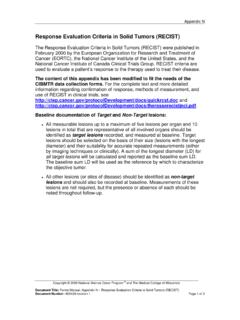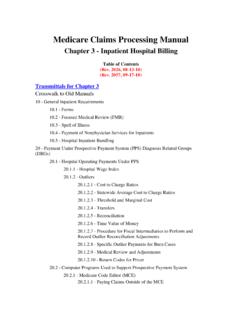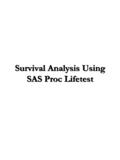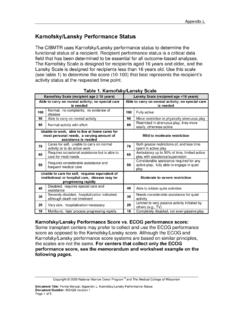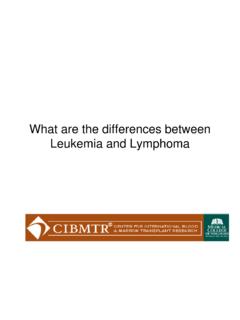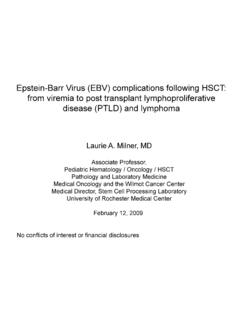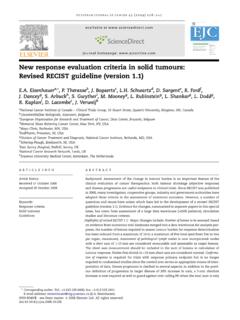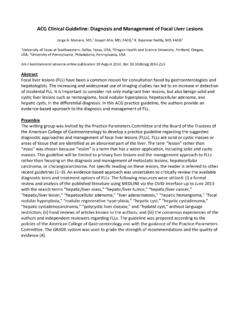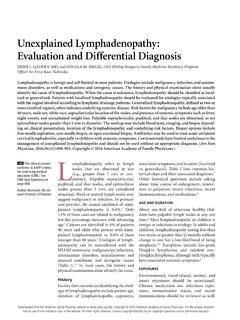Transcription of Response Evaluation Criteria in Solid Tumors (RECIST)
1 Appendix N Copyright 2009 National Marrow Donor Program and The Medical College of Wisconsin Document Title: Forms Manual: Appendix N Response Evaluation Criteria in Solid Tumors (RECIST) Document Number: A00426 revision 1 Page 1 of 3 Response Evaluation Criteria in Solid Tumors (RECIST) The Response Evaluation Criteria in Solid Tumors (RECIST) were published in February 2000 by the European Organization for Research and Treatment of Cancer (EORTC), the National Cancer Institute of the United States, and the National Cancer Institute of Canada Clinical Trials Group.
2 RECIST Criteria are used to evaluate a patient s Response to the therapy used to treat their disease. The content of this appendix has been modified to fit the needs of the CIBMTR data collection forms. For the complete text and more detailed information regarding confirmation of Response , methods of measurement, and use of RECIST in clinical trials, see and Baseline documentation of Target and Non-Target lesions: All measurable lesions up to a maximum of five lesions per organ and 10 lesions in total that are representative of all involved organs should be identified as target lesions recorded, and measured at baseline.
3 Target lesions should be selected on the basis of their size (lesions with the longest diameter) and their suitability for accurate repeated measurements (either by imaging techniques or clinically). A sum of the longest diameter (LD) for all target lesions will be calculated and reported as the baseline sum LD. The baseline sum LD will be used as the reference by which to characterize the objective tumor. All other lesions (or sites of disease) should be identified as non-target lesions and should also be recorded at baseline. Measurements of these lesions are not required, but the presence or absence of each should be noted throughout follow-up.
4 Appendix N Copyright 2009 National Marrow Donor Program and The Medical College of Wisconsin Document Title: Forms Manual: Appendix N Response Evaluation Criteria in Solid Tumors (RECIST) Document Number: A00426 revision 1 Page 2 of 3 Response Criteria for Target and Non-Target lesions: Evaluation of target lesions Complete Response (CR) Disappearance of all target lesions for a period of at least one month Complete Response Unknown (CRU) Complete Response with persistent imaging abnormalities of unknown significance Partial Response (PR) At least a 30% decrease in the sum of the longest diameter of measures lesions (target lesions), taking as reference the baseline sum of the longest diameter.
5 Stable Disease (NR/SD) Neither sufficient shrinkage to qualify for PR nor sufficient increase to qualify for PD, taking as reference the smallest sum of the longest diameter since the treatment started Progressive Disease (PD) A 20% or greater increase in the sum of the longest diameter of measured lesions (target lesions), taking as reference the smallest sum LD recorded since the treatment started or the appearance of one or more new lesions Evaluation of non-target lesions Complete Response (CR) Disappearance of all non-target lesions and normalization of tumor marker level Incomplete Response / Stable Disease (SD) Persistence of one or more non-target lesion (s) or/and maintenance of tumor marker level above the normal limits Progressive Disease (PD) Appearance of one or more new lesions and/or unequivocal progression of existing non-target lesions (1) (1)
6 Although a clear progression of non target lesions only is exceptional, in such circumstances, the opinion of the treating physician should prevail and the progression status should be confirmed later on by the review panel (or study chair). Appendix N Copyright 2009 National Marrow Donor Program and The Medical College of Wisconsin Document Title: Forms Manual: Appendix N Response Evaluation Criteria in Solid Tumors (RECIST) Document Number: A00426 revision 1 Page 3 of 3 Evaluation of best overall Response : The best overall Response is the best Response recorded from the start of the treatment until disease progression/recurrence (taking as reference for PD the smallest measurements recorded since the treatment started).
7 In general, the recipient s best Response assignment will depend on the achievement of both measurement and confirmation Criteria . Target lesions Non-Target Lesions New Lesions Overall Response CR CR No CR CR Incomplete Response /SD No PR PR Non-PD No PR SD Non-PD No SD PD Any Yes or
8 No PD Any PD Yes or No PD Any Any Yes PD Source.
